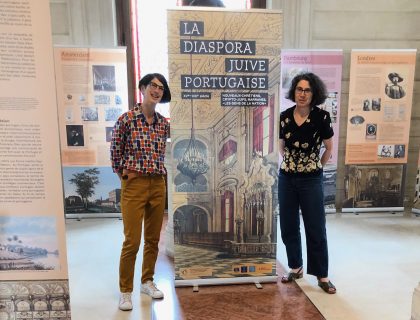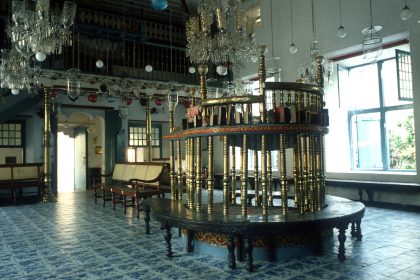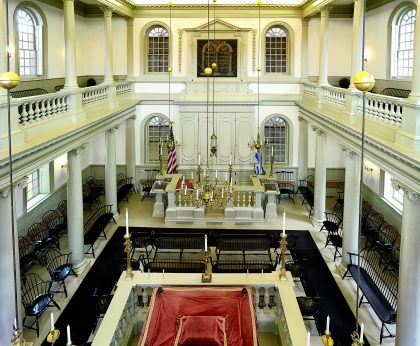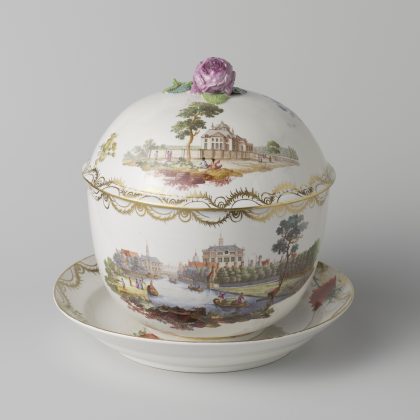A magnificent travelling exhibition offers to (re)discover the Portuguese Jewish history. It has the particularity of including this history in that of modern Europe and thus covers six centuries. Among its descendants, are Baruch Spinoza and Pierre Mendès France. Here’s our interview with Livia Parnes, who conceived this exhibition proposed by the Chandeigne publishing house.

Jguideeurope : How did this exhibition project come about?
Livia Parnes : Chandeigne publishing house, which specialises in the Portuguese-speaking world, presents this exhibition as an extension of one of its collections, Péninsules, founded and directed by Anne Lima. Publishing documents and essays on the question of identity and acculturation, notably under the prism of relations between religions, the collection seeks to make better known the specificity of Portuguese Jewish history, which remains lesser known, or too much associated with that of Spanish Judaism. Yet, the history of Portuguese Judaism has different characteristics that will have major consequences on its evolution. It is a religious, socio-economic, intellectual and world history that we wanted to share and make known. The exhibition places the history of the Portuguese-Jewish diaspora within the context of the history of modern Europe. It covers six centuries.
In such a perspective, the idea of this exhibition answers to one of the ambitions of Chandeigne which is to expand the books beyond the paper, and to link them to other artistic forms. For years, Chandeigne has been organizing cultural events, producing musical readings, concerts, workshops and theatrical adaptations… The exhibition intends to share the richness of the abundant history of Portuguese judaism and make it accessible to a very wide audience, both informed and uninformed. Synthetic, didactic and richly illustrated (photos, reproductions of paintings, manuscripts, frontispieces, maps, etc.), the exhibition contains 20 panels, which can be easily adapted to different spaces and presented in various places: libraries, cultural or research centres, museums, town halls, schools, etc.

One of the fascinating elements is the number of countries where the Portuguese Jewish diaspora migrated, how do you explain this?
First of all, this history is about persecution and about people being hunted by the Inquisition, established in 1536 in Portugal. One of the big differences with Spain is that these migrants had been forcibly converted (1497); they left as “new Christians”. Among them were many merchants, some of them quite wealthy. They migrated in search of places to practice their Judaism more or less freely, especially in the Ottoman Empire, but also in search of better living conditions. The time was right: it was the dawn of mercantilism, and for the Portuguese it was the beginning of maritime expansion and colonialism. Thus, both victims and agents of colonial empires, they quickly became involved in all the sectors of the emerging Atlantic trade and the first “world economy”: spices, sugar, tobacco, textiles, wine, precious stones, money. Some also participated in smuggling and the slave trade. Their family, commercial and financial networks spread across the globe: from Lisbon to Goa, via Northern Europe or the Middle East, but also from Lisbon to the Caribbean and the Americas. Finally, as we see in the exhibition, various local authorities (princes, dukes, municipalities) welcomed them, granting privileges and religious protection, interested in the benefits they hoped to gain from the Portuguese Jews’ merchant activity and trade networks. This kind of “mercantile philosemitism” was particularly the case in Italian cities (Ancona, Livorno, Venice, Ferrara), in France, in Amsterdam, in London, in Hamburg…

What discovery during the research for the exhibition particularly surprised you?
Without it being a real discovery, the exhibition allowed us to really grasp how, despite the great geographical but also religious dispersion of this diaspora, the Portuguese-Jewish Diaspora will create over the generations a dynamic inter-community space, whose unifying factors are mainly expressed through language, literature, liturgy, architecture, patronymics or even funeral art. Although composite in nature, this diaspora has been able to share a community of destiny and to nurture a strong memorial link with Portugal while leaving its mark on the host communities. This dispersion even gave rise to a new form of collective belonging, referred to as “A Nação” (the Nation) or “the Portuguese Jewish Nation”, which perpetuates the memory and their Jewish and Portuguese ties.
Likewise, the exhibition makes perceptible the fact that the first Jewish presences in North America from the 17th century onwards – first in New Amsterdam (future New York), and then in five other cities – were communities of Portuguese and Spanish Jews, before the great wave of Ashkenazi Jews. It was also interesting to note that the liberal Jewish current originated in the Portuguese Jewish communities (Charleston, Savannah…).
Finally, the few months in which the exhibition has been presented confirm in a way our starting point and what motivated us to conceive this project, namely that this rich and long history of Portuguese Judaism is still very little known. People who have visited the exhibition seem to discover a whole new side of Jewish history and European history, which for us is one of the greatest merits of this exhibition.

Which cities will host the exhibition next, and will it also be accessible online?
In Paris, after several places that hosted the exhibition before the summer (the Marguerite Audoux library, the Paris Centre town hall), the exhibition will be presented as part of the France-Portugal cross-over season at the Maison du Portugal – Cité internationale universitaire Bd Jourdan, 75014 Paris. From 10 September to 4 October 2022.
On 27 September at 8pm, we are organising a solo piano concert and a four-handed piano concert Musical Paths, with an original programme of works by composers of Jewish and Portuguese origin from the 20th century to the present day, in which motifs from Jewish music are mixed with traditional Portuguese tunes. Galerie Hus – 4 rue Aristide Bruant – Paris 18. For more information: galeriehus@gmail.com

In Blois, the exhibition will be presented as part of the festival Les Rendez-vous de l’histoire. Hall INSA – 3 rue de la Chocolaterie, Blois, 41000. From Monday 3 October to 9 October 2022.
In Lisbon, a Portuguese version of the exhibition will be presented in partnership with the Hagada Association and the future Jewish Museum of Lisbon at the Biblioteca Palácio Galveias. From 12 to 29 October 2022.
In Bourges, the exhibition will be presented at the Town Hall, located at 11 rue Jacques Rimbault, 18000 Bourges. From 20 October to 3 November 2022, with a conference scheduled on the first day.
In Bordeaux, the exhibition will be presented within the frame of the 140th anniversary of the synagogue of Bordeaux (an extremely important city in the history of Portuguese Jews, where the family of Pierre Mendès France is based, among others!) It takes place at the synagogue from 9 November to 15 December 2022.
The exhibition includes about fifteen QR codes that link to a companion site Travelling exhibition – The Portuguese Jewish Diaspora, which offers extensions to the visit for those who wish to go deeper into certain aspects. Articles, additional images and some videos can be found on the website.